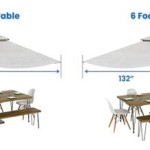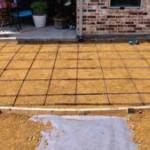Enhancing Outdoor Spaces: Concrete Patio Construction with Brick Edging
A concrete patio provides a durable and versatile platform for outdoor living. Its robust nature allows for heavy use, making it suitable for entertaining, dining, and simply relaxing in the open air. The addition of brick edging elevates the patio's aesthetic appeal, contributing to a more polished and defined outdoor space. This article will explore the process of constructing a concrete patio with brick edging, focusing on key considerations and techniques that ensure a successful and long-lasting result.
The combination of concrete and brick represents a harmonious blend of functionality and style. Concrete offers strength and stability, while brick provides a touch of classic charm and visual interest. The edging serves not only as a decorative element but also as a practical border, containing the patio surface and preventing erosion or displacement of surrounding materials. A well-constructed concrete patio with brick edging can significantly enhance a property's value and curb appeal.
Planning and Preparation: Foundation for Success
The initial phase of any construction project is critical, and constructing a concrete patio with brick edging is no exception. Proper planning and preparation lay the groundwork for a successful outcome. This stage involves assessing the site, determining the dimensions of the patio, and selecting the appropriate materials. A thorough understanding of these elements is essential before any physical work begins.
The first step is to assess the site where the patio will be located. This involves evaluating the existing soil conditions, drainage patterns, and any potential obstructions. Soil composition can significantly impact the longevity of the patio; poorly draining soil can lead to cracking and instability. If the soil is primarily clay, it may be necessary to amend it with gravel or other materials to improve drainage. Drainage patterns should be carefully considered to ensure that water flows away from the patio and any adjacent structures.
Determining the dimensions of the patio is another crucial aspect of the planning phase. The size and shape of the patio should be proportionate to the surrounding landscape and accommodate the intended use. Consider the furniture, such as tables, chairs, and grills that will be placed on the patio. Measure the available space and create a detailed plan or sketch outlining the patio's dimensions and layout. This plan will serve as a guide during the construction process.
Material selection plays a vital role in the patio's overall appearance and durability. The choice of concrete mix should be appropriate for outdoor use, with consideration given to local climate conditions. The brick used for the edging should be compatible with the concrete in terms of color and texture. Consider using pavers specifically designed for edging, as they are often more durable and easier to install. It is also important to calculate the amount of materials needed, including concrete, brick, gravel, sand, and any necessary tools or equipment. Purchasing slightly more materials than estimated can help account for waste and unforeseen circumstances.
Construction Process: Pouring Concrete and Laying Brick Edging
The construction process involves several key steps, beginning with excavation and formwork, followed by pouring the concrete and finally, installing the brick edging. Each step requires careful execution to ensure a structurally sound and aesthetically pleasing patio. Following proper techniques and best practices is crucial for a lasting result.
Excavation is the first physical step. The area designated for the patio needs to be excavated to a depth that will accommodate the gravel base, concrete slab, and brick edging. The depth typically ranges from 6 to 12 inches, depending on the soil conditions and the desired thickness of the concrete slab. Ensure that the excavated area is level and compact the soil to provide a stable base for the gravel. A plate compactor can be used to achieve optimal compaction.
Formwork is essential for shaping the concrete slab and providing a framework for pouring the concrete. Construct forms using lumber, ensuring that they are securely staked and level. The forms should be positioned according to the dimensions outlined in the initial plan. The inside of the forms should be treated with a release agent to prevent the concrete from sticking. Reinforcement, such as wire mesh or rebar, should be placed within the formwork to enhance the concrete's strength and prevent cracking. The reinforcement should be elevated slightly off the ground to ensure it is fully encased in concrete.
Pouring the concrete is a critical step that requires careful attention to detail. The concrete mix should be prepared according to the manufacturer's instructions. Pour the concrete evenly within the formwork, starting from one corner and working across the entire area. Use a shovel or rake to spread the concrete and ensure it fills all the gaps. Once the concrete is poured, use a screed board to level the surface. A screed board is a long, straight piece of lumber that is dragged across the forms to remove excess concrete and create a smooth, even surface. After screeding, use a bull float to further smooth the surface and remove any imperfections. Allow the concrete to cure for several days, keeping it moist to prevent cracking. Curing typically involves covering the concrete with plastic sheeting or spraying it with water regularly.
Installing the brick edging typically occurs after the concrete has partially cured but is still pliable enough to set the bricks. Apply a layer of mortar along the edge of the concrete slab. Position each brick carefully, ensuring that it is level and aligned with the adjacent bricks. Use a rubber mallet to gently tap the bricks into place, embedding them securely in the mortar. Maintain consistent spacing between the bricks, using spacers if necessary. After the mortar has dried, fill the joints between the bricks with more mortar, using a pointing tool to create a smooth, professional finish. Clean any excess mortar from the brick surfaces before it hardens completely.
Design Considerations and Customization Options
While the technical aspects of patio construction are crucial, design considerations play a significant role in creating a functional and aesthetically pleasing outdoor space. Customization options allow homeowners to tailor the patio to their specific needs and preferences, resulting in a unique and personalized area.
The choice of brick for the edging can significantly impact the patio's overall appearance. Consider the color, texture, and size of the bricks. Red bricks are a classic choice that complements most architectural styles. However, other options, such as gray, brown, or even multi-colored bricks, can add visual interest. The texture of the bricks can also vary, from smooth to rough, depending on the desired aesthetic. The size of the bricks should be proportionate to the size of the patio and the thickness of the concrete slab.
Patterned brick edging can add a decorative element to the patio. Several patterns can be created using bricks, such as a running bond, herringbone, or basketweave. These patterns can enhance the visual appeal of the patio and create a more dynamic design. The choice of pattern should be based on personal preference and the overall style of the landscape. Installing patterned brick edging requires more precision and planning than a simple linear edging.
Adding features such as built-in seating, fire pits, or planters can further customize the patio. Built-in seating can create a comfortable and inviting space for relaxation and entertainment. Fire pits can provide warmth and ambiance, extending the use of the patio into the cooler months. Planters can add greenery and color, creating a more natural and inviting environment. These features should be integrated into the patio design from the outset to ensure a cohesive and functional outdoor space. Consider drainage when incorporating planters to prevent water damage to the patio surface.
Surface treatments for the concrete can enhance its appearance and durability. Staining the concrete can add color and depth, mimicking the look of more expensive materials such as natural stone. Sealing the concrete can protect it from staining, cracking, and weathering, extending its lifespan. Stamped concrete is another option that can create the appearance of various textures, such as brick, stone, or wood. The choice of surface treatment should be based on personal preference and the desired aesthetic. It is important to follow the manufacturer's instructions when applying surface treatments to ensure proper adhesion and longevity.
Lighting can dramatically transform the ambiance of the patio, especially during the evening hours. Consider incorporating landscape lighting, such as path lights, spotlights, or string lights, to create a warm and inviting atmosphere. Lighting can also highlight specific features of the patio, such as the brick edging, plants, or architectural elements. The type and placement of lighting should be carefully planned to achieve the desired effect. Solar-powered lights are an energy-efficient option that can be easily installed without the need for wiring.

How To Install Brick Edging Around A Patio Building Bluebird

Brick Border Concrete Patio Home Ideas Flooring Landscaping

Decorative Concrete Patio With Brick Patterned Border Bill S Custom Contractors Okc

Nice Curved Paving With A Border Patio Table And Chairs Bbq Garden Grass G Concrete Brick Patios Stones

Rock Salt Finish Concrete W Brick Border Craftsman Patio Dallas By Urban Oasis Outdoor Living Houzz

Concrete Patio With Stamped Border Extension Ideas Cement

Edging Patiotown Com

Rock Salt Finish Concrete W Brick Border Craftsman Patio Dallas By Urban Oasis Outdoor Living Houzz

Plastic Edge Restraint Vs Concrete Which Is Better Western Interlock

Expert Concrete And Flatwork Services By Curb N Decor For Your Outdoor Living Space
Related Posts








